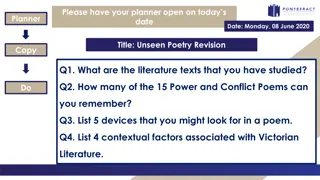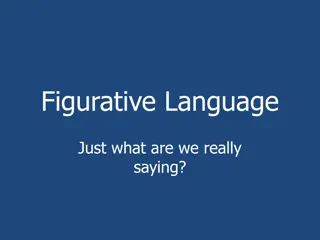Understanding Figurative Language Techniques in AP Literature Poetry
Exploring the purpose of figurative language in poetry adds depth and emotion to the text. Learn about key techniques like symbolism, metaphor, simile, personification, and allusion. Discover advanced concepts such as metonymy, synecdoche, allusion, synesthesia, hyperbole, and more. Delve into the power of imagery to engage the senses and enhance the overall poetic experience.
Uploaded on Nov 25, 2024 | 0 Views
Download Presentation

Please find below an Image/Link to download the presentation.
The content on the website is provided AS IS for your information and personal use only. It may not be sold, licensed, or shared on other websites without obtaining consent from the author. Download presentation by click this link. If you encounter any issues during the download, it is possible that the publisher has removed the file from their server.
E N D
Presentation Transcript
AP LITERATURE POETRY FIGURATIVE LANGUAGE TECHNIQUES
WHAT IS THE PURPOSE (IN GENERAL) OF FIGURATIVE LANGUAGE IN POETRY? When we encounter a figurative language device, exploring meaning and connotation brings a deeper level of meaning to the poem in general. Attaches emotion Provides comparison Allows for a deeper understanding of the situation or the speaker Provides contextual development
THE BASIC 5 YOU NEED TO KNOW Symbolism Representing an idea or object (person, place, thing) with an object Metaphor Controlling vs. extended vs. simple Simile -uses like or as to make the comparison Personification Giving a non-human thing human-like characteristics Allusion See next slide
FANCY METAPHORS: Metonymy What an object stands for an idea or bigger object E.g. The Crown - for the King or The White House for the U.S. Government Synecdoche When a part represents a whole E.g. Nice set of wheels = Car Allusion A reference to literature, history, pop culture, the Bible, mythology
EVEN FANCIER TERMS Synesthesia Mixing of the senses e.g. cold blue , bitter cold , warm colors Hyperbole Exaggeration Litotes/ Understatement The opposite of exaggeration- using a double-negative to emphasize the positive E.g. She is not a beauty queen, I am not as young as I used to be, not bad Oxymoron A seemingly impossible phrase the emphasizes opposites E.g. Jumbo Shrimp Paradox A seemingly impossible situation or scenario that illustrates irony "Nobody goes to the restaurant because it's too crowded."
WHAT ABOUT IMAGERY? This is NOT technically a FIGURATIVE device! It is often literal description Remember different types for the 5 senses: (these are adjectives that come before imagery ) Gustatory (taste) Auditory (sound) Tactile (feel) Visual (sight) Olfactory (smell)























